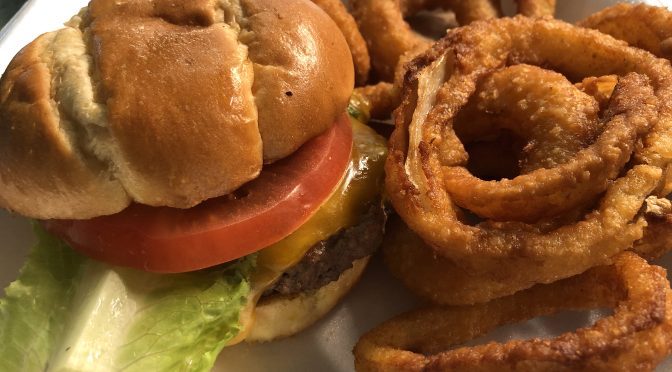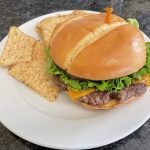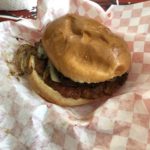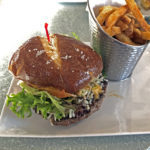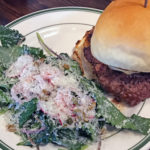Some days you feel like a burger. Some days you feel like a steak. But let’s make one thing perfectly clear: This is not a matter of better and best. The simple, honest burger in no way takes second place to the faux nobility of the tenderloin, rib eye, strip, or porterhouse. Sometimes, when you’re in a certain mood, nothing but a burger will do.
Feeling like a burger and having a burger on your plate can be two different things, though. Do you get out and buy dinner, or do you make your own? There’s a lot to be said for making your own: You save costs, and you control the ingredients, the preparation, the heat, the toppings, even the decision whether to add a slice or two of cheese.
But how do you make your burger as good as it can be? To find out, we asked for advice from a half-dozen local burger experts, restaurant chefs who’ve earned the people’s ovation and fame forever for the quality of their grilled ground-beef patties.
This city has so many great burger joints, not to mention high-end eateries that make great burgers, that it wasn’t easy to narrow the pool down to six, so I went for a random cross-section. Apologies if I missed your favorite.
I invited each chef to respond to two simple questions:
- What are your secrets about making great burgers for your customers?
- What do you advise people who want to make great burgers at home?
Here, only lightly edited, is just about everything they told us.
Six Forks Burger Co., Co-owner and Chef Troy King
In the restaurant: I think it’s all in the meat. We use a special blend of 73/27 Black Angus. (The numbers represent the percentages of lean meat to fat, respectively.) It’s all fresh beef, nothing frozen. We get it from Creation Gardens every day. What’s crazy, a lot of people think we season the burgers, but we don’tt. I don’t season it at all. I cook it on high heat to get good caramelization, then cook it a little less on the other side. The 73/27 ratio to me has a little bit higher fat count (than the 80/20 restaurant standard), so when you cook it fast you are pretty much searing it, and that’s our secret. When cold meat hits the hot surface of our flat top grill, you get the Maillard effect, the caramelized sear that gives browned food its delicious flavor. We really depend on that, so we’ve found cooking the burger at lower temp doesn’t do as well. We don’t want people to taste the meat and confuse the flavor profile by mixing it up with salt and pepper and toppings. Flat top grill, very high heat, and finally, we cook all the burgers fresh. No burger hits the grill until it’s ordered. When we assemble the burger, all the veggies are under the meat, never on top. Even lettuce, tomato, onion and pickle go on the bottom bun, then cheese, then the meat. Sauces or condiments go on top. When you bite down, you taste the sauces, then the meat, and then the veggies.
Home cooking tips: At home, I prefer a thin patty. If you want it thick, stack several thin ones. Most places the burgers have cheese on top only. Make your burger like those we sell , with cheese on top and cheese on the bottom of each patty, whether it’s one patty, two or three. This way the juices from the burger, instead of going into the bun, are are stopped from doing that by the cheese. I know a lot of people like flame broiled burgers. They like the juice hitting the coals and coming back up as flavor and steam, but you lose a lot of juiciness that way. I like to use a flat plate, pref, cast iron.
The Certified Black Angus beef burgers at Six Forks Burger Co. range in price from $5.95 (for the Lil Burger with no cheese) to $7.95 (for the full-size cheeseburger with two patties and three slices of cheese).
Six Forks Burger Co.
1270 S. Preston St.
565-9750
facebook.com/sixforksburgers
The Fat Lamb, Co-owner and Chef Dallas McGarity
In the restaurant: We start by using high quality ingredients. Then we make sure that the bun is toasted properly with a little olive oil. We don’t use butter because we use brioche buns that are already very rich. We don’t mix anything with our beef, we just season it properly before cooking. Our burger is cooked on a flattop and smashed. There is a technique for this that I think makes our burger come out just right. It helps develop a nice crispness to the outside but cooks it quickly so it doesn’t dry out the meat. Practice makes perfect on this one.
Home cooking tips: Don’t be afraid to season the meat, and make sure you have a high-temperature heat source to cook on. I like to put a cast-iron griddle on top of my outdoor grill to create a super hot flat top grill at home.
The Fat Lamb’s diner-style double cheeseburger on brioche bun is $15.
The Fat Lamb
2011 Grinstead Drive
409-7499
fatlamblouisville.com
facebook.com/fatlamblouisville
Grind Burger Kitchen, Co-owner and Chef Jesse Huot.
In the restaurant and at home: I’d have to say the one thing that makes the biggest quality impact for a burger is fresh ground beef. The fat content and, to a lesser degree the specific cuts used, are still important, but very cold beef put through a grinder is going to make a better burger. It’s also important to trim off as much silver skin as possible. You’ll know when you see it. It’s a big reason why cheap burger meat shrinks up. When ground into beef and cooked, it tightens up into unpleasant, chewy bits. Get it out of there! Some great grocery store cuts to try are chuck, boneless short rib (which is usually just the beautiful well-marbled bottom part of the chuck) and brisket. For the brisket, just make sure the cubes of fat are mixed in evenly with the lean for better distribution. For cooking: on a grill or cast iron, hot and fast is the only way. Throw down an extra patty to cut into while cooking to check for doneness. You can eat that one in your underwear over the sink later.
All of Grind’s burgers are 1/3 pound of house-ground, hand-trimmed, grass-fed beef cooked to order. The basic build-your-own burger is $13.
Grind Burger Kitchen
829 E. Market St., Suite C
213-0277
grindburgerkitchen.com
facebook.com/grindburgerkitchen
Burger Boy: Owner Dan Borsch
In the restaurant: We start with quality beef, an 80/20 Black Angus burger, never frozen. We season the burger with mix of black pepper, salt, and white pepper, and cook it on a flat top grill so it sears in the juices on the outside. We’ll cook it to order to make it piping hot, and put it on a locally sourced Klosterman Baking Co. bun – quality bread, toasted with real butter. Add a little mayo and fixings to your liking.
Borsch, who purchased the Old Louisville eatery that was originally Juanita’s Burger Boy about eight years ago, says he has tweaked the recipe a little over time but it basically remains the same at Burger Boy and his Burger Girl restaurant in Crescent Hill; his Hillcrest Tavern in Crescent Hill uses a similar procedure but uses a hand-pattied burger and puts it on a brioche bun.
Home cooking tips: Come up with a seaaoning ratio that you like. Don’t forget to toast the bun with real butter. Real butter and that crispy toasted layer make it pop. A charcoal grill gives the best heat, but use what you’ve got.
Burger Boy’s Black Angus quarter-pounder is $5.99. A double quarter-pounder is $7.99.
Burger Boy
1450 S Brook St.
635-7410
burgerboydiner.com
facebook.com/Burger-Boy-Diner-44334368603
80/20 at Kaelin’s, Executive Chef and Owner Matt Staggs
In the restaurant: My favorite burger out of our lineup (a half-dozen options including the $11.50 original cheeseburger) is our ribeye burger. It is ground in-house using a coarse die. There are a few key elements to my favorite burgers. The first is the beef being well seasoned: We use only kosher salt and coarse-ground black pepper. I have found that an 8-to-1salt-to-pepper ratio is my favorite blend. The second most important element to a solid burger is the crust. My favorite burgers all have a nice sear and crispy edges. To get the crust you want, you have to find the Goldilocks territory: Too cold and one gets gray meat; too hot and the burger is blackened and bitter. I look for a very deep brown crust. We have custom-made cast iron flat tops to help us get the crust, I am a huge proponent of solid surfaces as opposed to grilling over grates. We run our flat tops between 450 to 550 degrees. The third key element is texture and contrast among seared crust, gooey cheese, crunchy lettuce and onions, and sweet tomatoes. In balancing the contrast of our burgers we think of savory/acidity/sweet/salt. Savory-beef acid-pickled sweet-sauce-tomatoes salt-pepper. Finally,, the key to avoiding soggy buns is letting the burger rest for 2 or 3 minutes before putting it on the bun.
Home cooking tips: Use a very hot pan or grill, season well, and once you’ve put it down, don’t move the burger til it’s ready to flip. You’ll know it’s time to flip when juices purge through the surface, and you can tell it’s cooked to medium when juices purge through the top on the second side.
The rib eye burger at 80/20 at Kaelin’s is $14.
80/20 at Kaelin’s
1801 Newburg Road
200-8020
8020atkaelins.comf
facebook.com/8020atKaelins
instagram.com/8020kaelins
Shady Lane Cafe, Co-owner Carol Reeves
In the restaurant: We use ground beef, a 70/30 blend of lean to fat. We season it and patty it, trying not to touch it too much while forming it because we don’t want to compress it. We like a nice, big one-third pound burger. We cook ours on a flat top grill, using a light weight sitting on top of it, not a heavy one. We use a brioche bun and dress it however the customer likes. You can add gourmet toppings – we can do a brie and grilled onion burger, for example – but most people like our Brownsboro burger, a classic burger on brioche bun with lettuce, tomato, pickles, onion, cheese whatever you like.
Home cooking tips: Basically, don’t do too much to it. Touch it as little as you can so it stays juicy. Get that nice sear on it, and don’t try to hide the burger flavor, keep it simple, and let the burger show.
The one-third-pound Brownsboro Burger, dressed to order, is $8. It is pictured below and at the top of the page.
Shady Lane Café
4806 Brownsboro Road
Brownsboro Center
893-5118
shady-lane-cafe.business.site
facebook.com/shadylanelady
The proof of the burger is in the tasting
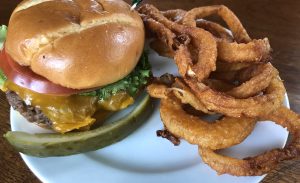
After all that talk about burgers, we had to have one, stat, so ran out and picked up a 1/3-pound Angus Beef Brownsboro Burger at Shady Lane Cafe. It’s a good one, a uniformly thick patty with good light texture, still pink at the center and perfect after a quick ride home. It came dressed with fresh, crisp romaine, a thick tomato slice, red onion and pickle chips, topped with melted yellow cheddar on a good brioche bun, with a dill pickle spear alongside.
